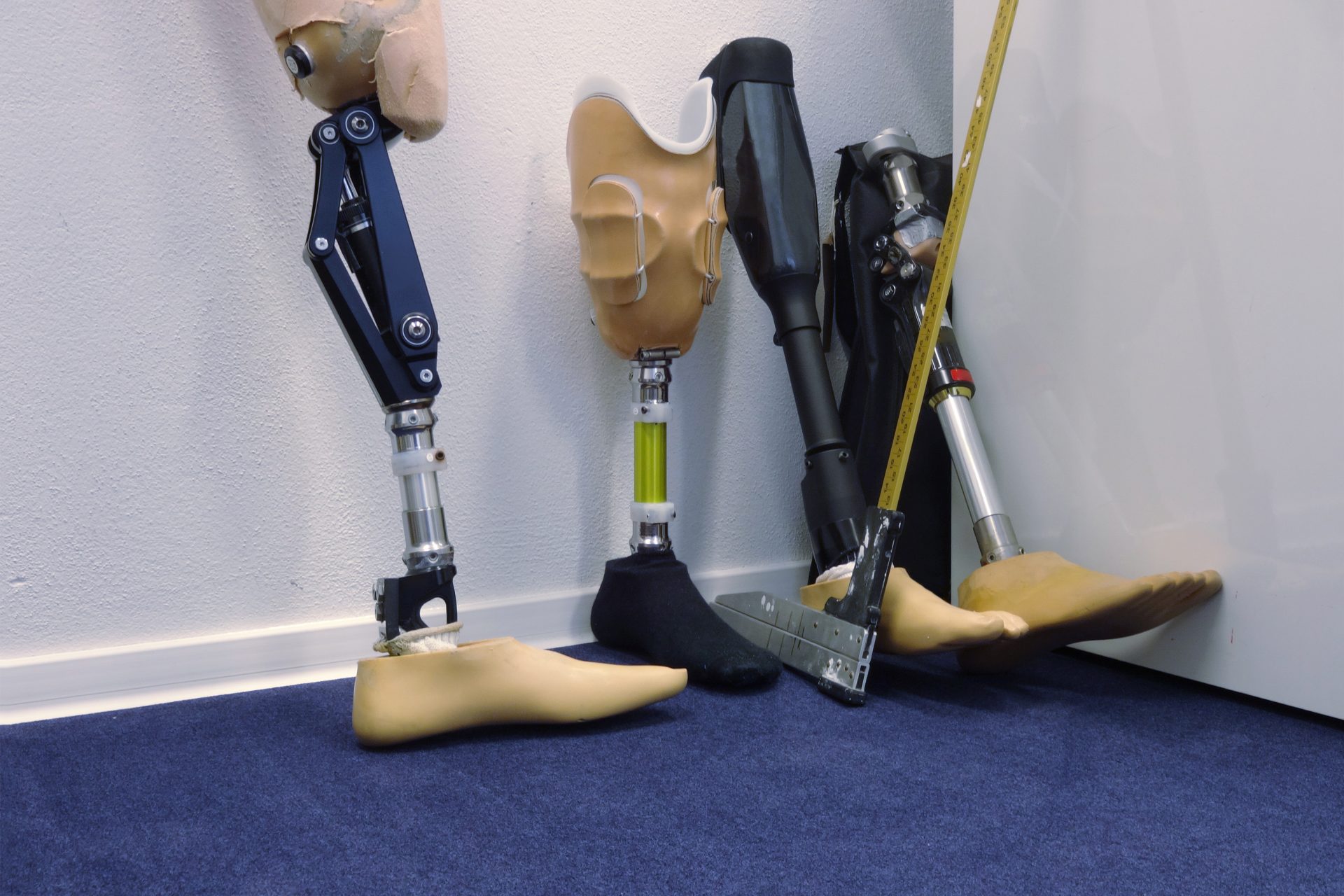
If you have been assessed as suitable for prosthetic use you will consult with a prosthetist regarding the making of a prosthetic limb.
The prosthetist designs, produces, fits and maintains prosthetic limbs. Prosthetists work in the public health system and in private practise. Depending on where you live you may start with a prosthetist based in your hospital while you are having rehabilitation.
Your prosthetist will provide you with education in regard to stump and prosthetic hygiene, correct application of the prosthetic limb and works with your physiotherapist to achieve the best outcome for you. They will also advise you on the limitations of your prosthesis, funding bodies and specialised components for recreational activities and work. Your prosthetist is the person to contact if you have any questions or needs relating to the fit, function or repairs to your prosthetic limb.
Choosing your prosthetist
In Queensland amputees can choose their own prosthetist after rehabilitation. Those who start with a hospital made prosthetic limb choose their prosthetist for continuing services. The most successful prosthetist and client relationships are built over time, so your prosthetist can become familiar with your unique needs. While recommendations from other amputees are valuable you may prefer a different personality and skill set in your prosthetist than another amputee. The following list contains questions to think about when choosing a prosthetist.
Convenience: You will need to visit the premises quite often so location is important. Also look for conveniences such as parking, building access and appointment availability. Keep in mind how you could get to appointments without a car.
Rapport: Talk to different prosthetists to see who you feel most comfortable with. Does your prosthetist listen to you and address your concerns? Are you treated respectfully by all the staff? Do you feel comfortable discussing problems with your prosthesis or does the prosthetist become dismissive or defensive?
Decision making: Do you like to be a partner in the decision making process? Look for a prosthetist that uses their knowledge to inform and guide you to make appropriate choices. Do you feel pushed towards components or given a ‘hard sell’ on items you do not need?
Experience and knowledge: Ask about the experience of the staff and if they specialise in your type of prosthesis. Can they answer questions and address concerns to your satisfaction? If they cannot answer a question do they source information and provide it to you at a later date?
Expectations: Does the prosthetist provide you with realistic expectations of your prosthesis? Are you provided with material outlining components and appropriate usage? Does the prosthetist tell you when your expectations are unreasonable and guide you to more suitable solutions?
After care: Does the prosthetist provide information on prosthesis care and maintenance? If you have concerns about fit and function are they addressed quickly or was the process drawn out? Are you contacted for regular maintenance visits?
When you consult with a prosthetist they will usually examine your stump and take details of your medical history. They should discuss your goals, suitable components and lifestyle factors that will affect your choice of components. They will need to record the size of your remaining foot and the type of shoes you wear, your stump circumference and where a prosthetic knee will be placed. The prosthetist will also decide at this stage how the limb will be held on, this will be determined by issues such as the level of amputation and the length of your stump.
At this point you should discuss component choice and which components best suit your needs and your budget.
Fitting a prosthetic limb
Once you have decided with your prosthetist on what type of prosthetic limb and components you need the building and fitting can begin. The first stage is to cast a realistic model of your stump. If you are happy to proceed a cast can usually be made during your first appointment.
Casting is done in two ways. The first method uses plaster of paris on bandages. The bandages are wrapped around the stump and then removed when the plaster has set. The prosthetist then fills the mould with plaster creating an exact replica of your stump. The second method uses a special camera which scans the stump and transfers the images to a computer operated carving machine to carve a replica of the stump out of solid material.
The stump replica is used to make a socket. Most sockets are resin however other materials such as carbon fibre are available. Resin is a two part liquid that hardens into a strong plastic when mixed together (resin cannot be poured straight onto a stump as it heats to over 180 degrees when hardening). You may have a ‘check socket’ cast, this is a temporary socket made of clear acrylic plastic. The prosthetist will use it to look for pressure spots or areas where the stump does not make contact with the socket before the final socket is made.
When the prosthetic limb is completed you will return for a fitting and trial. The prosthetist will watch how you walk to look for any problems and make necessary adjustments. They will then show you how to ‘don’ (put on) and ‘doff’ (take off) the prosthesis and liner. They should also give you instructions on how to maintain the limb and the limitations of the prosthesis.
Your first prosthetic limb will not have a cosmetic cover so that adjustments can be made frequently. As you become more active your stump will likely change in shape requiring several sockets in a relatively short space of time. Once the stump has stabilised your prosthetic limb should last for several years provided you maintain it as directed.
Most modern prosthetic limbs are designed to be “endoskeletal” this means they are like a human limb with a sturdy skeleton for support and a soft outer layer. When your stump has stabilised a cosmetic cover (cosmesis) can be fitted to the prosthetic limb. The cosmetic cover is made to match as close as possible to the shape and colour of your natural leg.
Depending on your lifestyle, work and recreational activities, three basic types of cosmetic covers are available: hard plastic, foam with removable stockings for colour, or foam with a silicone/vinyl ‘skin’ for colour. Some people prefer the appearance of the componentry and choose to not have a cosmetic cover, this has become quite popular as it is the preferred appearance for amputee athletes. For others realism is very important: cosmetic covers that are very realistic, including skin colour matching are available.
For those amputees whose activities could damage a foam cover; a prosthetic limb with a hard fibreglass exterior may be recommended. This is called an ‘exoskeletal’ prosthesis and is strengthened by its hard cover (like a crab hence the name). Some examples of activities that need a exoskeletal prosthetic limb include regular exposure to salt water, welding or other types of “dirty” work, as well as weight considerations. Exoskeletal limbs also work well for active children as the cover is very durable.
The most appropriate cosmetic cover for your prosthetic limb will be decided by you in consultation with your prosthetist.
Socks and Liners
Socks and liners are an important part of wearing a prosthetic limb. A socket on its own is too hard to be worn comfortably without some kind of soft interface between it and the stump skin. In below knee amputees a stump in a hard socket is likely to form painful pressure points, sweat excessively and create friction rubbing on the skin. Socks and liners allow normal changes in stump size without the socket falling off or becoming too tight. Socks also allow perspiration to be absorbed rather than causing the socket to slip.
Socks and sheaths
Socks are used to protect the stump from friction and to help keep the socket fitting snugly. Socks can be cotton, wool or synthetic. The advantage of natural material socks are that sweat is taken away from the skin, however modern synthetics and blends are catching up with natural fibres in terms of moisture absorption. Socks come in a variety of thicknesses (ply). This allows an amputee to mix and match plys to make a good socket fit and accommodate minor stump changes.
Nylon sheaths are an optional supply that are used as a moisture and friction barrier between the skin and other socks. Sheaths are similar in appearance to traditional hosiery but are specially made for prosthetic use.
Gel socks are a layered sock with an outside fabric layer and a layer of silicone or similar material in the middle. The advantage of these types of socks is that the silicon can mould to the stump’s surface and relieve pressure points.
Multiple socks can be worn at once to account for stump volume changes but see your prosthetist if you find yourself needing many socks at once, as a change in socket may be needed.
Liners
Two common liner materials available for amputees are silicone and pelite. These liners both achieve the same outcome: flexible cushioning that adjusts to the shape of the stump and muscle movement. Your choice of liner will be made in conjunction with your prosthetist as the design of your prosthetic limb will influence the type of liner that can be used.
Liners made from silicone are an alternative to socks or they can be used in conjunction with socks to provide a good socket fit. The material used to make the liner is soft and can conform to the stump relieving pressure and rubbing.
Many prosthetic limb styles use the vacuum created by a silicone liner to hold the stump in the socket. This is achieved by the addition of a lock and pin. The pin attaches to the liner and the lock is built into the socket. The wearer can then use the pin to lock the liner to the socket creating a firm hold. The stump is held in by the suction created by the silicone. Liners can be implanted with skin treatments to reduce skin irritation.
The other common type of liner is a pelite liner. Pelite is a kind of foam that can be heat moulded to the replica of the stump made in casting. These liners are soft but hold their shape. There are pelite alternatives on the market that use plastics; sometimes called a “flex socket” these are made in the same way as a pelite liner by heating and moulding over a cast of the stump.
The choice of liner will alter how the socket is made. If you do not like the type of liner you have it is usually necessary to remake the socket to accommodate a different type. Changing liner types is not a decision to be taken lightly as the stump becomes accustomed to a liner. Changing liner type does not appear to have any added benefits for many amputees (unless they have an allergy to the liner material) and some amputees find the change intolerable.
Always investigate the cause of pain or discomfort in your stump with your prosthetist and primary care doctor rather than assuming the type of liner is the problem or the solution to pain.
Prosthetics for lower limbs
While prosthetic limbs do not function as well as natural limbs, they can be very effective. Most people are able to resume much of the physical activity they had prior to the amputation. With the appropriate selection of prosthetic components and physical rehabilitation many amputees return to independent mobility and become confident prosthetic limb users.
After amputation surgery you will want to get back to daily living as soon as possible however you must wait until the stump is healing well and the swelling has stabilised. Your readiness for a prosthetic limb is decided on a case by case basis in consultation with your rehabilitation team but it typically takes six to eight weeks for the stump to be ready. You will use your first prosthetic limb to undertake walking practice and work with your physiotherapist to strengthen your residual limb. Arm amputees will use their first prosthetic limb to develop hand skills whilst the stump undergoes change.
Your first prosthetic limb is often provided by the prosthetic service in your nearest public hospital. This prosthetic limb will not have a cosmetic cover due to the amount of adjustments needed in the early stages of rehabilitation. Walking will cause significant stump changes for a period of four to six months therefore your first prosthetic limb will need multiple adjustments while the stump stabilises and your walking improves.
At the beginning of your prosthetic limb training you will need to use a walking aid. As your walking with a prosthetic limb improves you may be able to walk without any walking aids.
During prosthetic limb training you will be shown how to care for your stump and you may require assistance with pain management or experience phantom pain sensations. The length of a prosthetic limb training program varies depending on the individual for most amputees it will take several months for the stump to stabilise and mobility to improve.
Components of a leg prosthesis
The components chosen for your prosthesis will be based on a range of needs such as your weight, activity level, the level of amputation, work, where you live (for maintenance) and your other leg and knee/s. Your prosthetist will guide you through the components on offer and assist you with choosing components. High end components may not be best for you: you may find you prefer the durability and easy maintenance of lower tech options. The following is a basic description of common lower limb components.
Socket: The socket holds the stump and distributes weight. Most modern sockets are made from urethane resin. To determine the correct shape the socket will be cast either by putting plaster on the stump or by scanning the stump into a computer by using a cameralike device.
Suspension: The suspension holds the socket onto the stump. There are multiple kinds of suspension including cuffs, leather belts, corsets, vacuum suction, liner with pin, and elastic sleeves.
Knee: Mechanical knees have hinges that swing when you walk to create a more natural gait. Knees with multiple axes are more stable and allow faster walking than those with only one axis. If you have difficulty with stability, safety knees are available. Hydraulic knees have fluid filled cylinders and pistons to allow different walking speeds. Hybrid knees that combine mechanical hinges with pneumatic cylinders are available.
Foot and ankle: There are numerous feet available from wood to titanium. Ankles are not always needed however they are an option for those who want an adjustable heel height.
Pylon: Pylons create the length required for your limb and depending on their type can absorb shock and torque as you walk.
Components such as rotators are available and may suit your needs, your prosthetist can advise you on additional components.

